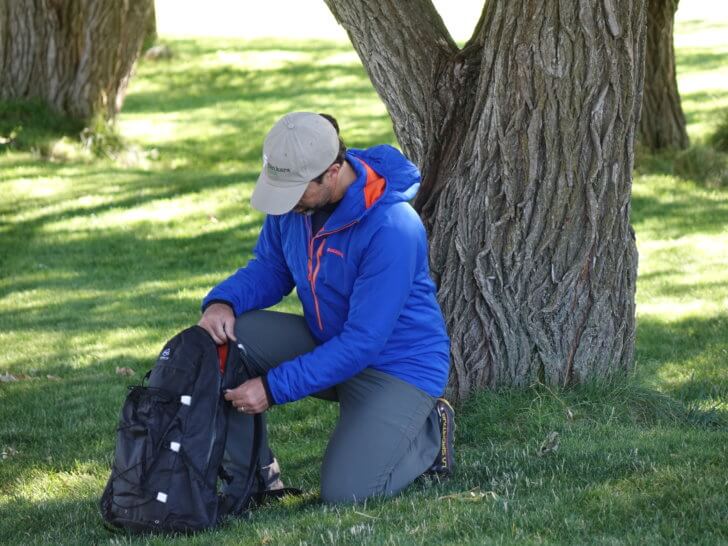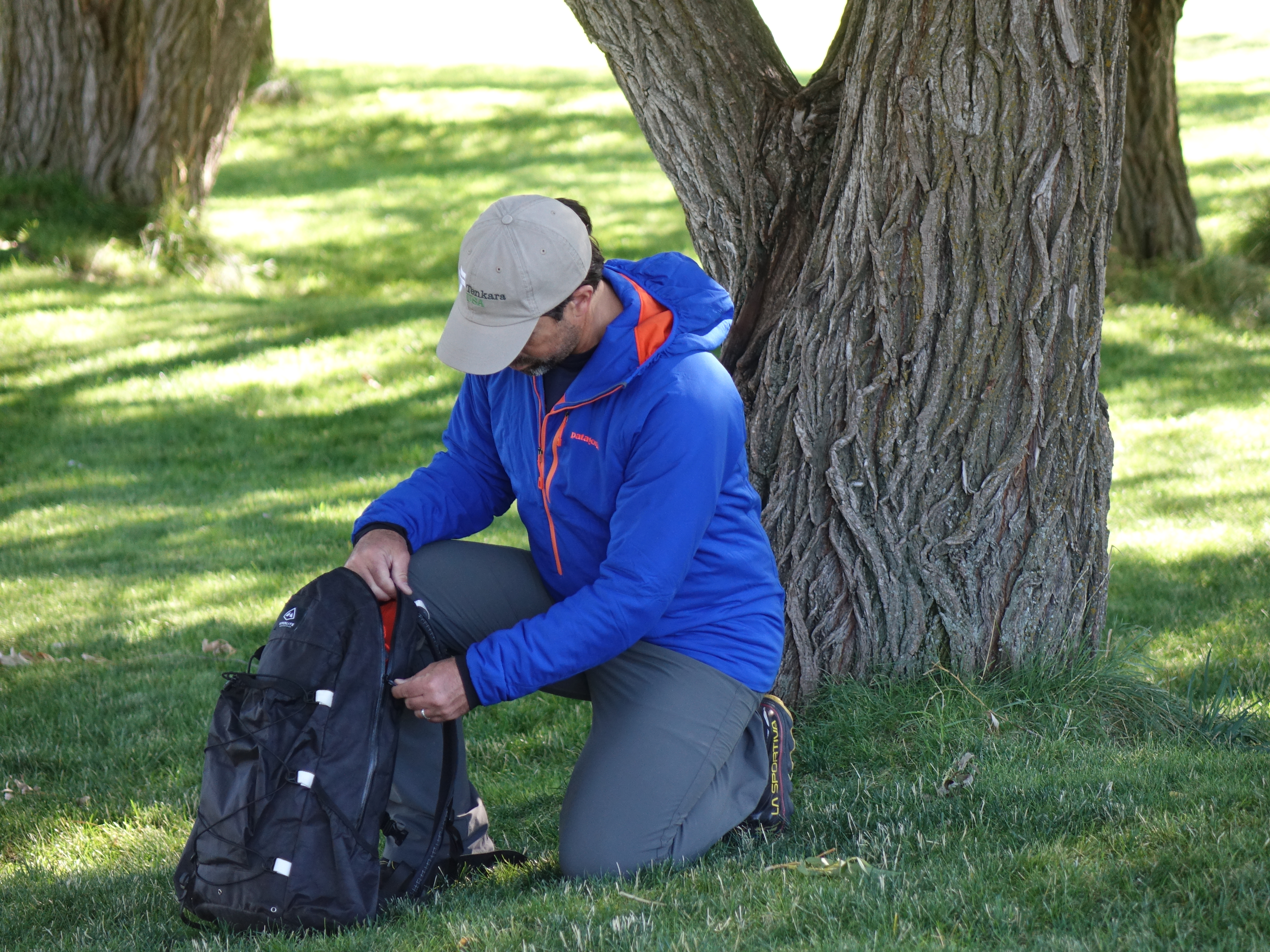Introduction

This Patagonia Nano Air Light Hoody Review takes a first look at a new product: a lighter iteration in the increasingly popular apparel category of “active insulation”.
These garments are insulated (usually with a synthetic fill). Instead of the insulation being sandwiched between layers of tightly woven (and often calendared) fabrics that enhance water resistance (but limit breathability), active insulation garments are shelled and lined with soft, stretchy woven fabrics that have very high levels of air permeability.
The Patagonia Nano Air Light Hoody is currently among the lightest of these garments, owing to its light insulation, light fabrics, and simple design – a pullover style with partial front zip, hood, one pocket, and no cuff or hem adjustments.
Applications
- Stop-and-go hiking at low-to-moderate levels of exertion in cold temperatures (e.g., fall/winter);
- Warm-up layer for hiking in the early mornings or when the temperatures dip for evening trekking;
- Light insulation layer under a shell for inactivity in typical two-to-three season conditions.
Features
- Slim, athletic fit;
- Minimal seams;
- Stretch fabric at wrist cuffs for snug but comfortable fit;
- Stretchy hood design can be pulled on or off without unzipping;
- Deep front zipper for ventilation;
- Single zippered chest pocket (exterior, left side);
- Hood fit for a normal head, not a helmet-clad head.
Specifications
- Shell: 1.6 oz/yd2 100% ripstop stretch nylon (30 denier);
- Lining: 2.0 oz/yd2 100% plain weave stretch nylon (50 denier);
- Cuffs: 4.7 oz/yd2 88% polyester/12% spandex stretch-woven;
- Insulation: 40 g/m2 synthetic fill with mechanical stretch;
- Air permeability: 70 ft3/min;
- Front zipper length: 18 in. (size M);
- Claimed Weight: 10.9 oz (manufacturer’s spec for size M);
- Measured Weight: 10.2 oz (size M)
Patagonia Nano Air Light Hoody Review: Commentary
I’ve experimented with several other “active insulation” pieces in the 13 to 17 oz weight range from Patagonia, Arc’Teryx, and Stio. I find them too warm to hike in for most backpacking conditions, even in the winter. But with the introduction of the Patagonia Nano Air Light Hoody, so-called “active insulation” tops are now in a similar weight class as hooded 50-100 weight fleece and ultralight, sewn-through-baffled down tops.
This may complicate gear selection for some, but those who spend a fair bit of time wearing a lightly insulated garment while trekking in cool and cold conditions should start paying attention to this category.
With a warmth-to-weight ratio higher than fleece, water-resistance that is markedly better than down, and a next-to-skin feel that is better than both, the Patagonia Nano Air Light Hoody could very well become a useful component in a lightweight backpacking clothing layering system.
This video captures my thoughts on the role of a lightweight active insulation piece in a backpacker’s clothing system:
While I think the Patagonia Nano Air Light Hoody would be a suitable primary insulation layer in summer conditions, I think its real strength is revealed as one of two insulating components for colder and/or inclement conditions trekking. One insulating layer would be optimized as an active layer while moving (i.e., the Patagonia Nano Air Light Hoody), and the other layer would be optimized for a maximum warmth-to-weight ratio (i.e., a high-fill down jacket). I plan to incorporate the Patagonia Nano Air Light Hoody into a four-piece torso layering system (where the Patagonia Nano-Air Hoody would effectively replace a 4 oz wind shirt) this fall as follows:
- Base Layer: Patagonia Merino 2 wool long sleeve crew (6.0 oz)
- Cold Weather Trekking Layer: Patagonia Nano Air Light Hoody (10.2 oz)
- Rain Jacket: Montane Minimus 777 Pullover (4.6 oz)
- Camp Insulation: Western Mountaineering Flight Down Vest (5 oz).
Of course, I think there is potential to incorporate an active insulation piece like the Patagonia Nano Air Light Hoody into a variety of different layering systems, and I’m looking forward to experimenting with it throughout the winter.
Strengths
- Lack of seams (creates a simple aesthetic, fewer failure points, and less binding, since seams don’t stretch);
- Mechanical stretch (allows for a slimmer design, less weight, and more comfort during active movement);
- Very lightweight considering its insulative value and wet weather resistance;
- Very high air permeability means that it can be used under a wider range of exertion levels, including cool-weather hiking, than synthetic or down insulating garments shelled and lined with tightly-woven nylon fabrics.
- Provides “insulated wind shirt” performance, similar to a wind shirt + fleece (e.g., “Pertex-and-Pile”) system, but with higher air permeability (system breathability).
Limitations
- High air permeability means that it must be coupled with a tightly woven shell garment (e.g., wind shirt or rain jacket) for extreme cold and wind.
- Slim fit may require upsizing for those with “bolder” (!) body types.
- Synthetic insulation not as durable over the long term as an similar wind shirt + fleece system.
Learn More
 More Info: More information about the Patagonia Nano Air Light Hoody is currently available at the Patagonia website. Also, stay tuned for a more in-depth review here at Backpacking Light.
More Info: More information about the Patagonia Nano Air Light Hoody is currently available at the Patagonia website. Also, stay tuned for a more in-depth review here at Backpacking Light.
Buy Online: Click this link to visit Patagonia.com to learn more or buy this product: Patagonia Men’s Nano Air Light Hoody.
Similar To: If you are looking for the slightly heavier full-zip version of this jacket, try the highly-rated Patagonia Nano Air Hoody, available from REI.com or Patagonia.com. This version would be more suitable for colder winter conditions, as a primary insulation piece for three-season conditions in the mountains, or for hikers who run colder and have a more difficult time staying warm.
Disclosure: The manufacturer provided a sample of this product to the author with no agreement, requirement, or obligation for media coverage of any kind. Thinking about buying this gear? You can support Backpacking Light in the process: if you click on the link to this product and make a purchase at the retailer website, the retailer will contribute a portion of the sale to help support Backpacking Light. It doesn’t increase your cost, and it helps us maintain our site, fund content development, and grow member services! Thanks!




Home › Forums › Patagonia Nano Air Light Hoody Review (First Look)